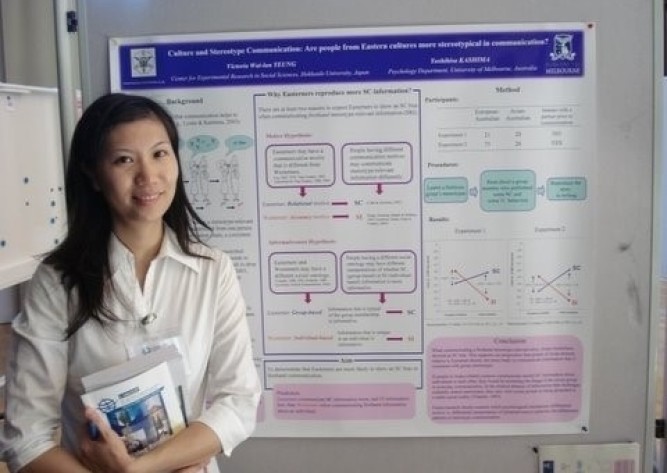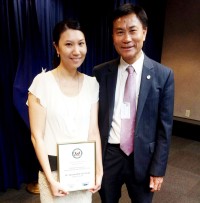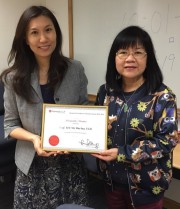Communication of stereotypes in society

Communication is essential to the social life of human beings. We, as in a group-living habitat, rely on it for exchanging information, building relationships and creating a more civilised world. While communication adds value to social harmony, on the other hand, messages with negative connotations or rumours sustain or even power up through ongoing propagation. Arising from prevalence of online social platforms such as Facebook and discussion forums, cyber-bullying is typical yet devastative result of disseminating offensive messages across netizens. What can we do to promote social harmony, instead of generating unpleasant personal insults?
Possessing her expertise in social psychology, Prof Victoria Yeung Wai-lan, Assistant Professor in the Department of Applied Psychology, is dedicated to investigate the relationship between communication and stereotypes. She joined the University in 2011, winning the Honourable Mention Award in the Research Excellence Award Scheme and the Fulbright - RGC Hong Kong Senior Research Scholar Award in 2014 and 2015 respectively for her research endeavours.
Communication and maintenance of stereotypes in society
“Communication, the verbal and nonverbal interaction between two or more interdependent individuals, would contribute to the maintenance of stereotypes if conducted at a large collective level.” Prof Yeung further explained that stereotypes are socially shared beliefs and expectations we hold about certain social groups. Stereotypes can actually be positive, neutral, and negative. Unfortunately, most stereotypes circulating in our society carry negative connotations. To explain the stereotypes’ self-perpetuating cycle of maintenance, she quoted the Mainland China-Hong Kong conflict as an example, “there are increasing anti-Mainland sentiments among Hong Kong people. Hong Kong people in general hold negative stereotypes of Mainland Chinese tourists and immigrants. During daily life communication, people tend to communicate information that is consistent rather than inconsistent with the existing stereotypes. Such communication activities gradually reinforce and maintain the negative stereotypes of Mainlanders. This can also be reflected by the use of various derogatory terms to describe the Mainlanders.”
While stereotype plays its role in cultural conflicts, it emerges even if you grasp nothing about a person’s background but only his or her physical appearance. We can easily form immediate impression of others based on their body shapes and types. To understand how weight stereotype affects our first impression, Prof Yeung has conducted an interesting field experiment on how people develop, inherit and propagate impressions on an unfamiliar overweight individual. Resembling a traditional party game “The Broken Telephone”, it showed random people on the street with a fictitious story about an overweight man and had them verbally reproduced the story to another person. The story consisted of comprehensive attributes which were either consistent, neutral or inconsistent to typical stereotypes on obesity. Based on the reproduced message, the listener carried on to tell the story to the next person until the tale reached the last person. So, what could they recall and what had they omitted? It came to Prof Yeung’s attention that not only did most participants emphasise the negative traits but they even exaggerated or made up the unfavourable connotations. “The results showed us how communication maintains and reinforces the negative stereotypes of obese people, as communicators tend to transmit the obesity-related stereotypical information and drop out the counter-stereotypical information,” said Prof Yeung, explaining how the experiment simulated the process of information transmission in our social networks.
Reducing stereotyping and prejudice
“Education can enhance our understanding of individual differences, reduce stereotyping and prejudice. The service-learning element in Lingnan’s curriculum exposes students to multicultural interactions with people from diverse backgrounds, and helps students realise that individuals are unique idiosyncratic entities that are not necessarily defined by group stereotypes,” she pointed out the importance of social contact and communication as the best way to improve human relations and reduce prejudice. “We offer a general education course entitled ‘Human Relationship and Interpersonal Skills in Organisations’ for undergraduates, aiming at brushing up our students’ interpersonal and communication skills which are conducive to social harmony.” Prof Yeung hopes to instill in her students a sense of appreciation towards diversity in society.
Devoted to exploring topics on stereotypes, Prof Yeung is planning to conduct some new research projects like cross-cultural differences in the expression and experience of stereotypes. “Bias, prejudice and even discrimination could happen primarily based on a single cue such as physical appearance, gender, or occupation” she hopes her research would help people gain insights into stereotypes and stereotype change.



